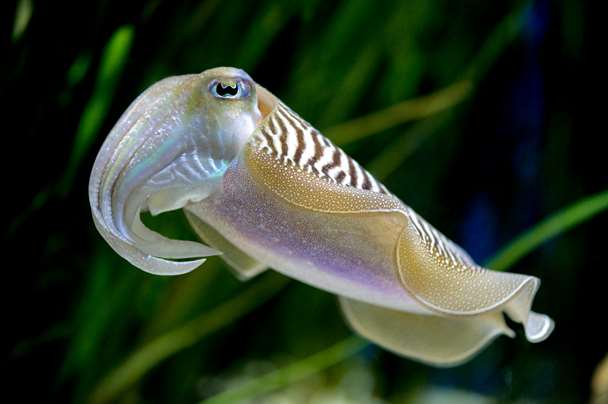Cuttlefish, or cuttles are fascinating aquarium/52-marine-animals.html">marine animals, closely related to squids and octopuses, known for their remarkable intelligence, complex behavior, and ability to rapidly change color. One of the most intriguing features of cuttlefish is their ability to spray ink when threatened. But is this behavior instinctive, or does it involve learned or adaptive strategies? In this article, we will explore the nature of cuttlefish ink-spraying, how it works, and whether it is truly an instinctive behavior.

Cuttlefish ink-spraying is a defense mechanism that allows these creatures to escape predators. When threatened, cuttlefish eject a dark cloud of ink from a specialized organ called the ink sac. This ink, primarily composed of melanin, not only clouds the water but also contains compounds that can confuse or irritate potential threats, giving the cuttlefish time to flee.
This ink is expelled in a jet-like spray, and the cuttlefish can aim it with remarkable precision. The ink serves to obscure the predator's view and disrupt their hunting behavior, making it more difficult for the predator to track the cuttlefish. The cuttlefish then uses its jet propulsion to quickly escape to safety.
The answer is yes—ink-spraying is largely an instinctive behavior in cuttlefish. This means that when cuttlefish are exposed to dangerous situations or threats, they instinctively rely on their ink-spraying mechanism to defend themselves. Like other cephalopods, the response to danger is hardwired into their behavior.
However, it is essential to note that while the ink-spraying reflex is instinctive, cuttlefish can also demonstrate flexibility in how they use this defense. For example, some cuttlefish may choose not to ink in situations where they perceive that using ink might not be necessary or if it could be a waste of energy or resources. This shows that while the ink-spraying reflex is automatic in response to threats, there is some level of decision-making involved.
The ink-spraying behavior is an evolutionary adaptation that plays a crucial role in the survival of cuttlefish. Here’s how it helps:
Visual Obscuration: The ink creates a dense cloud that can obscure the predator's vision, allowing the cuttlefish to disappear or blend into its surroundings. This cloud can disorient or confuse predators like fish or larger aquarium/52-marine-animals.html">marine animals, giving the cuttlefish time to escape.
Chemical Distraction: In addition to visual camouflage, cuttlefish ink contains compounds that may act as chemical irritants. These chemicals can cause temporary disorientation or discomfort in the predator, further enhancing the cuttlefish’s ability to escape.
Jet Propulsion Escape: When a cuttlefish ejects ink, it often uses this moment to propel itself away from the threat using its powerful jet propulsion system. The ink cloud helps mask its movement, allowing for a quick and stealthy getaway.
While ink-spraying is an instinctive behavior, cuttlefish may not always use it in every situation. Several factors determine when and how cuttlefish deploy this defense:
Threat Perception: Cuttlefish are intelligent animals and can assess the level of threat they are facing. If the danger is immediate and substantial, they will spray ink as a last resort. However, if they can escape quietly or hide in their environment, they might not ink at all.
Environmental Conditions: Cuttlefish might be more likely to ink in certain environmental conditions. For instance, they may be more inclined to use ink in open water where there are fewer places to hide, but may choose not to ink if they are in complex or rocky environments where they can quickly camouflage.
Predator Type: The response also varies depending on the type of predator. Against smaller or less immediate threats, cuttlefish may rely more on camouflage or speed rather than ink-spraying. Against larger or more dangerous predators, ink-spraying is more likely to be used.
Although cuttlefish are highly intelligent animals, their ink-spraying behavior is primarily instinctive rather than learned. However, research suggests that cuttlefish can learn to associate certain stimuli with danger over time, which can enhance their ability to use ink in specific situations. This learning process involves classical conditioning, where the cuttlefish might associate the presence of certain predators or environmental cues with the need to eject ink.
In captivity, cuttlefish may also demonstrate adaptive behaviors and learn how to use their environment to hide or escape more effectively, further refining their defense strategies.
While the primary function of ink-spraying is self-defense, there is evidence that cuttlefish ink may also play a role in communication. In some instances, cuttlefish may release ink to confuse or deter other cuttlefish or even use it to signal other animals in the area. This suggests that while ink-spraying is largely a survival mechanism, it could also have social and interactive functions in certain contexts.
In conclusion, ink-spraying in cuttlefish is primarily an instinctive behavior that plays a crucial role in their survival. It is a highly effective defense mechanism that helps them avoid predators and escape dangerous situations. While there is some level of flexibility in how cuttlefish use this behavior, it is largely a hardwired reflex that has evolved to ensure their safety.
By understanding the biology behind cuttlefish ink-spraying, we can better appreciate how these remarkable creatures have adapted to thrive in their environments. Whether it's through camouflage, jet propulsion, or chemical deterrents, the ink-spraying behavior of cuttlefish showcases their incredible ability to survive in the wild.
How Cuttlefish Use Camouflage to Hide from Predators
The Intelligence of Cuttlefish: Problem-Solving and Memory
Cuttlefish Anatomy: How Their Ink Works and Why It’s So Effective
By learning about these behaviors, we gain a deeper understanding of the fascinating world of cuttlefish and their remarkable survival strategies.
animal tags: Cephalopoda
We created this article in conjunction with AI technology, then made sure it was fact-checked and edited by a Animals Top editor.